
Jan Brueghelthe Elder was a Flemish painter and draughtsman. He was the son of the eminent Flemish Renaissance painter Pieter Bruegel the Elder. A close friend and frequent collaborator with Peter Paul Rubens, the two artists were the leading Flemish painters in the first three decades of the 17th century.
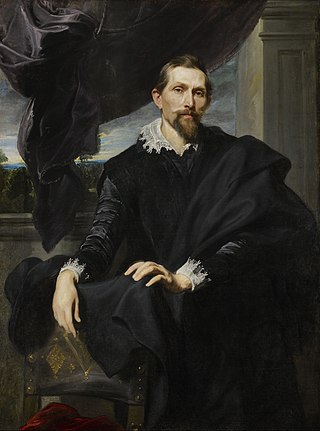
Frans Snyders or Frans Snijders was a Flemish painter of animals, hunting scenes, market scenes, and still lifes. A versatile artist, his works depict all sorts of foods, utensils and tableware and wide assortment of animals. He was one of the earliest specialist animaliers and he is credited with initiating a wide variety of new still-life and animal subjects in Antwerp. His hunting scenes and still lifes engage the viewer with their dramatic and dynamic effects. He was a regular collaborator with leading Antwerp painters such as Peter Paul Rubens, Anthony van Dyck, Jacob Jordaens and Abraham Janssens.

David Teniers the Younger or David Teniers II was a Flemish Baroque painter, printmaker, draughtsman, miniaturist painter, staffage painter, copyist and art curator. He was an extremely versatile artist known for his prolific output. He was an innovator in a wide range of genres such as history painting, genre painting, landscape painting, portrait and still life. He is now best remembered as the leading Flemish genre painter of his day. Teniers is particularly known for developing the peasant genre, the tavern scene, pictures of collections and scenes with alchemists and physicians.
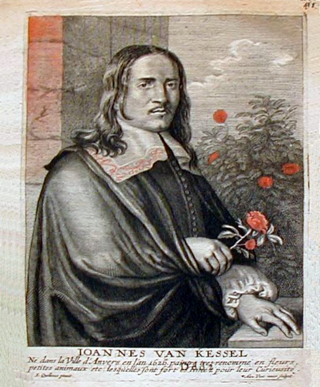
Jan van Kessel the Elder or Jan van Kessel (I) (baptized 5 April 1626, Antwerp – 17 April 1679, Antwerp) was a Flemish painter active in Antwerp in the mid 17th century. A versatile artist he practised in many genres including studies of insects, floral still lifes, marines, river landscapes, paradise landscapes, allegorical compositions, scenes with animals and genre scenes. A scion of the Brueghel family many of his subjects took inspiration of the work of his grandfather Jan Brueghel the Elder as well as from the earlier generation of Flemish painters such as Daniel Seghers, Joris Hoefnagel and Frans Snyders. Van Kessel’s works were highly prized by his contemporaries and were collected by skilled artisans, wealthy merchants, nobles and foreign luminaries throughout Europe.

Jan van Kessel the Younger or Jan van Kessel II, known in Spain as Juan Vanchesel el Mozo or el Joven, was a Flemish painter who after training in Antwerp worked in Spain. Known mainly for his portraits he became a court painter to the King and Queen of Spain. A few landscapes and mythological and allegorical scenes have also been attributed to him. He was formerly believed to have been active as a landscape painter, but this is now no longer generally accepted.

Joos de Momper the Younger or Joost de Momper the Younger was a Flemish landscape painter active in Antwerp between the late 16th century and the early 17th century. Brueghel's influence is clearly evident in many of de Momper's paintings. His work is situated at the transition from late 16th-century Mannerism to the greater realism in landscape painting that developed in the early 17th century. He achieved considerable success during his lifetime.

Flemish Baroque painting was a style of painting in the Southern Netherlands during Spanish control in the 16th and 17th centuries. The period roughly begins when the Dutch Republic was split from the Habsburg Spain regions to the south with the Spanish recapturing of Antwerp in 1585 and goes until about 1700, when Spanish Habsburg authority ended with the death of King Charles II. Antwerp, home to the prominent artists Peter Paul Rubens, Anthony van Dyck, and Jacob Jordaens, was the artistic nexus, while other notable cities include Brussels and Ghent.

Willem van Herp (I) or Willem van Herp the Elder (variations on first name: 'Guilliam', 'Gilliam' and 'Guillaume') (c. 1614 in Antwerp – 1677) was a Flemish Baroque painter specializing in religious paintings and small cabinet paintings of "low-life" genre scenes. He operated a large workshop and through his good connections with Antwerp art dealers helped spread the Flemish Baroque style internationally.

Jan van den Hecke or Jan van den Hecke the Elder (1620–1684) was a Flemish Baroque painter, draughtsman, printmaker and engraver, mainly known for his still lifes, landscapes and battle scenes. After training in Antwerp, he spent time in Rome, where he had important patrons. After his return to Flanders, he worked for a while in Brussels, probably painting flower still lifes for Archduke Leopold Wilhelm of Austria, the Austrian governor of the Spanish Netherlands, before returning to work in Antwerp.
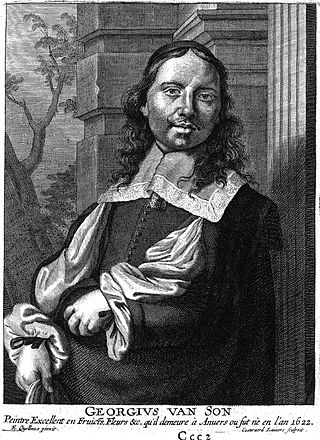
Joris van Son or Georg van Son was a Flemish still life painter who worked in a number of sub-genres but is principally known for his still lifes of fruit. He also painted flowers, banquets, vanitas still lifes and pronkstillevens. He is known to have painted fish still lifes representing the Four Elements, and also collaborated with figure artists on 'garland paintings', which typically represent a devotional image framed by a fruit or flower garland.
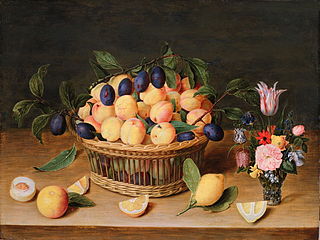
Jacob van Hulsdonck or Jan van Hulsdonck, was a Flemish painter who played a role in the early development of the genre of still lifes of fruit, banquets and flowers.
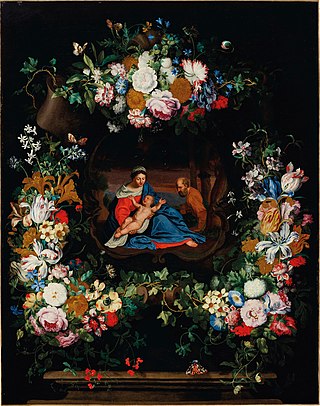
Jan Pieter Brueghel or Jan Peeter Brueghel was a Flemish painter who specialised in flower still lifes and garland paintings. A scion of the famous Brueghel family of painters, he trained in Antwerp with his father and later worked in Liège, Paris and Italy.
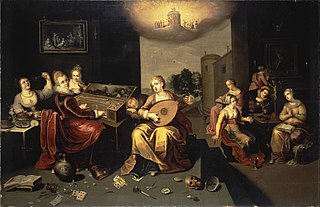
Hieronymus Francken the Younger or Hieronymus II was a Flemish painter and one of the most prominent members of the large Francken family of artists. Along with his brother Frans Francken II he played an important role in the development of new genres in Flemish art in the early 17th century. He was a prolific artist with a wide range who painted religious scenes, allegorical subjects, portraits, fruit pieces, genre scenes, architectural paintings and art galleries.
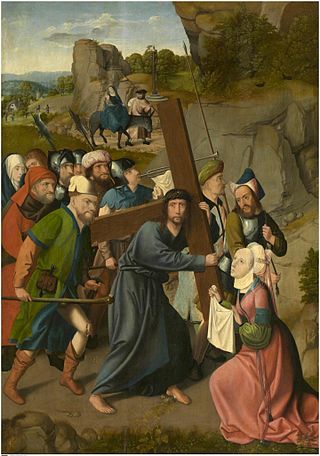
The Master of Hoogstraeten is the Notname given to a Flemish painter or a collective of painters active in Antwerp in the early 16th century. The master created principally religious paintings and is considered a member of the Antwerp Mannerists.

Abraham Teniers was a Flemish painter and engraver who specialized in genre paintings of villages, inns and monkey scenes. He was a member of artist family Teniers which came to prominence in the 17th century. He was also active as a publisher.

David Rijckaert II was a Flemish painter and art dealer active in Antwerp. He contributed to the early development of still lifes as an independent genre through his delicate rendering of banquets and sumptuous tabletop still lifes.
Klaus Ertz is a German art historian specializing in the Brueghel family of artists and their workshop.

Jan van Kessel or the other Jan van Kessel was a Flemish painter of still lifes of fruits, hunting pieces and flowers. After training in Antwerp he moved to the Dutch Republic where he is recorded as operating a studio in Amsterdam.

The Pseudo-Simons is the notname given to a painter presumed to have been active in Antwerp in the second half of the 17th century and the attributed author of 100 works, principally of fruit and flower still-lifes and pronkstillevens.

The Master of the Von Groote Adoration is a notname given to an artist or a number of artists or various workshops active in Antwerp sometime between 1500 and 1520. Whereas there are significant variations in the style of the works attributed to the master, the repetitions of certain subjects played an important role in the composition of the oeuvre. The master is considered a representative of the group of Antwerp mannerists who created works in an extravagant style in the early sixteenth century.





















